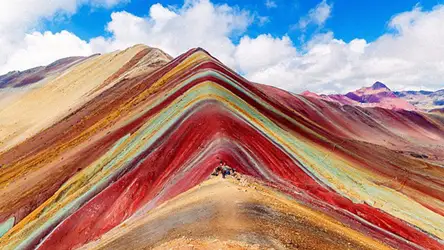The Rainbow Mountain, also known as Vinicunca or simply ‘Rainbow Mountain,’ has become one of Peru’s most outstanding attractions.
The Colors of the Mountain in Perú
Located over 100 kilometers from the city of Cusco, at an impressive altitude of 5,200 meters above sea level (masl), this mountain formation is a unique natural spectacle worldwide. Its slopes and summits are tinted with a palette of colors, including red, purple, green, yellow, and pink, among others.
Since 2016, this astonishing destination has attracted hundreds of visitors daily, becoming one of the most popular places to visit in Cusco, second only to Machu Picchu.

Have you ever wondered why it’s called the Mountain of 7 Colors? The answer lies in the complex mineral composition of the area. The multicolored shades result from the overlapping layers of different minerals on the mountain.
Among these minerals are red clay and mud, which contribute to the pink hue, clay that gives the red, sandstone that provides the white, marl that contributes to the lavender color, clay and copper oxide that translate into green, and limonites that add the yellow-brown touch. These natural substances began to form 65 million years ago when snow and water covered these slopes and summits.
Over time, extreme weather conditions uncovered the snow, revealing what is today one of Cusco’s most impressive tourist destinations. Over millennia, the sediments stratified into different layers, creating the colorful stripes that captivate visitors.
Location and Altitude
This natural wonder is located in the Andes of Peru, in the department of Cusco and the province of Canchis, at a staggering altitude of 5,200 masl. Originally known as the ‘Cerro Colorado’ by the people of Pitumarca, the Rainbow Mountain gained notoriety thanks to its proximity to the majestic Ausangate snow peak.
In 2016, photos shared by adventurous explorers on Facebook and Instagram propelled its popularity.
How to Get There
Accessing this natural wonder requires a road trip of just over 100 kilometers from the city of Cusco. After approximately 2 hours of travel on the Longitudinal de la Sierra del Sur Peruano highway, you’ll reach the town of Cusipata.
From there, the journey continues on a dirt road that leads to the community of Phulawasipata. From this point, you’ll embark on a 5-kilometer hike up the mountain slopes. You can choose to do this hike on foot or on horseback, as there are tours that offer this service.
Climate
As expected in a high-altitude region in Cusco, the climate is cold and can be challenging. Rain, wind, and altitude sickness (soroche) are potential obstacles for travelers.
Temperatures can drop below zero degrees Celsius, and rain can surprise you at any time of the year. To make the most of your visit, be sure to bring a rain poncho and suitable warm clothing.
Flora and Fauna
The Rainbow Mountain is home to a variety of fauna typical of the high Andes, including llamas, alpacas, and vicuñas. Local residents breed horses that can serve as transportation for visitors. Additionally, the region is covered in ichu, a natural Andean grass.
Tours to the Rainbow Mountain

Although this picturesque summit used to be a destination on the route to the Ausangate snow peak, nowadays, the most common way to visit it is through tours. These tours can be one or two days long and typically include transportation, meals, entrance fees, and the guidance of a professional.
In the city of Cusco, you’ll find numerous tourism agencies offering these services.
Self-Guided Visit
If you prefer to venture on your own, it is also possible to visit the ‘Cerro Colorado.’ To do so, you should take a bus to ‘Sicuani’ from the city of Cusco and disembark in the town of Cusipata.
Then, take a shared taxi to the Phulawasipata community, where the hike to the Rainbow Mountain begins. The entrance fee is 15 soles for Peruvians and 25 soles for foreigners.
Mountain Difficulty
The hike to the Rainbow Mountain takes approximately 2 hours, depending on your physical condition. It is not a dangerous hike but requires a moderate to high level of physical effort, with stretches of considerable inclines both uphill and downhill.
However, keep in mind that the cold weather and icy winds can present additional challenges. To avoid altitude sickness (soroche), it is recommended to acclimatize for one or two days in the city of Cusco before embarking on the hike.






